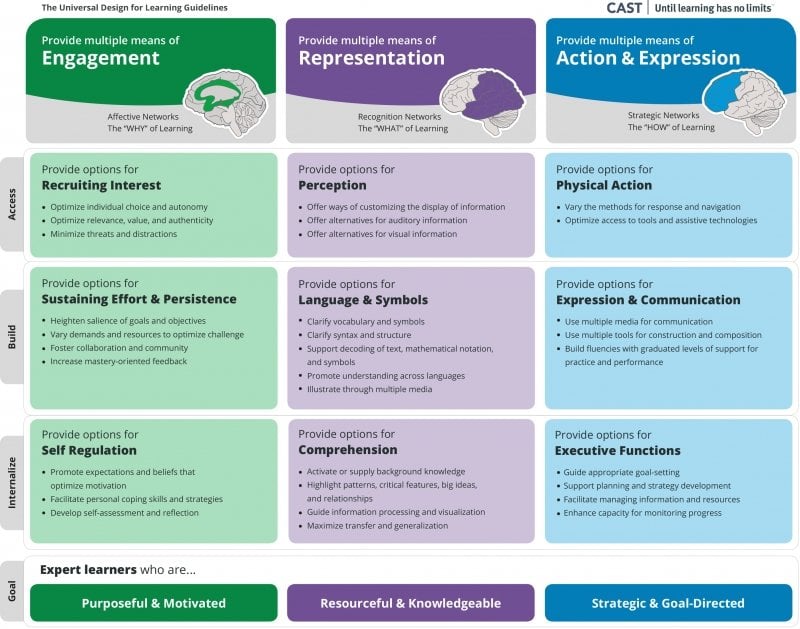Universal Design for Learning (UDL) is a framework to enhance teaching and learning based on the science of how people learn. As an inclusive educational practice, it supports Michigan Tech’s goal of ensuring all learners (including learners with disabilities) can access their educational materials and demonstrate mastery of course learning goals.
The Higher Education Opportunity Act of 2008 says UDL:
-
provides flexibility in the ways information is presented, in the ways students respond or demonstrate knowledge and skills, and in the ways students are engaged; and
-
reduces barriers in instruction, provides appropriate accommodations, supports and challenges, and maintains high achievement expectations for all students, including students with disabilities and students who are limited English proficient.
The UDL framework is composed of three principles; provide multiple means of engagement, representation, and action & expression. These principles are supported by specific guidelines and more detailed checkpoints. The supporting Access guidelines are designed to reduce instructional barriers and increase access to instructional materials and methods. These guidelines are a logical starting point as you begin learning about and applying UDL in your instruction.

Three Principles of UDL
Multiple Means of Engagement
Strategies that engage and motivate students to be successful learners are reflective of their diverse characteristics and backgrounds. While some students like a well-structured approach where course activities are well defined and predictable, other students may prefer flexibility and spontaneity. Some students prefer independent study while others value interactions with their peers. Providing multiple means of engagement is important to better address the needs of all students.
Provide options for recruiting interest
Information that is not processed is effectively inaccessible to learners. Attracting learner attention and interest is a recurring challenge for instructors and is made more difficult when considering individual learner preferences. Identifying alternative approaches to address learner interest is important.
Multiple Means of Representation
Learners perceive and comprehend information differently. Those with various sensory or cognitive disabilities require different approaches to assessing the information. Some learners process information more efficiently in visual or auditory formats versus printed text. Because one means of representation cannot be optimal for everyone, providing options is important.
Provide options for perception
Imperceptible information impedes learning. To ensure information is accessible to all learners provide it in multiple modalities (hearing, vision) and allow it to be adjusted by the learner (enlarge text, adjust sound level, etc.) to suit their preferences.
Multiple Means of Action and Expression
Learners have diverse strategies for engaging learning environments and in demonstrating their mastery. Those with physical impairments (e.g., cerebral palsy), problems with organizational abilities (executive function disorders), or language barriers, engage learning tasks differently.
Provide options for physical action
It is important to provide options for learners to interact with instructional materials and to demonstrate comprehension and mastery of skills and course learning goals.
Learn more about Universal Design for Learning
- UDL Guidelines from CAST
- UDL Research Evidence
- Watch 2019 Upper Peninsula Teaching and Learning Conference Keynote: "Reach Everyone and Teach Everyone with Universal Design for Learning" (presented by Thomas J. Tobin)
To discuss ways to apply UDL principles to your teaching contact the Jackson CTL to arrange a consultation.
Complete UDL Framework and Supporting Guidelines
